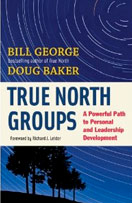Bill George and Doug Baker. True North Groups: A Powerful Path to Personal and Leadership Development. San Francisco: Barrett-Koehler Publishers, Inc.. 2011.
During the last year I have been in a process of interviewing CEOs and entrepreneurs, We have talked a lot about their development as individuals that prepared them to be effective in leader roles in their businesses and elsewhere. Experience, education, training and practices have all played an important role. And I thought I had re-discovered another factor that was vital to their successes – the support group.
Bill George is well known for his books, Authentic Leadership and True North and perhaps less known for his Seven Lessons for Leading in Crisis. His best known leader role was as CEO of Medtronics. Subsequently, he has been teaching in Harvard’s School of Business.
Doug Baker headed up Training for Pilsbury before starting his own consulting firm. He departed from this for a period of time as VP of Human Resources for Medtronics while George was CEO. He coauthored he coauthored Twelve-Step Wisdom at Work and has been teaching in MBA programs. He has begun the True North Institute, presumably to promote the effective use of support groups, particularly in business.
It turns out that George and Baker were there long before me in their understanding of theimportance of support groups. Despite similarities in age and span of experience, they participated in an ongoing support group that met weekly. They hold this group to be instrumental in their successes. In fact, they have intereviewed many individuals, mostly executives, who have participated in True North Groups and have concluded that weekly works best. This points to one of the key elements in the success, not just of the groups, but that experienced by the individual members – a commitment to frequent and ongoing meetings.
I was told about a similar group by one of the CEOs that I interviewed. It could be the same group. His simplified version of the story was that there is a group that has been meeting in Minnesota for thirty years. They meet once a week. During those years, at least one of them became a billionaire and all the other millionaires. If that lights up your achievement aspirations, so be it. But the thing we find in this book, as in the stories of the CEOs is that the use of support groups is much deeper than that suggests.
I thought I was onto something. If you want to be successful in developing yourself to step into and be effective in leader roles, you have to have an ongoing support group. But I had only scratched the surface. I hadn’t made much headway on what made these groups so important beyond the fact that each grew a culture of openness and trust in which personal and business/organizational challenges could be aired, feedback was direct and free flowing, and attention was focused on the whole individual, not just a piece.
There are all kinds of support groups out there – book clubs, 12 step, coffee klatches, sewing circles, hobby clubs, Young Presidents Organization groups, Entrepreneur Organization forums, etc. We continue to form and meet in such groups because they serve a purpose from which we can derive camaraderie, self-reflection with feedback, knowledge and skill development and so on.
George and Baker have captured the nature of successful groups and more.
In addition to drawing on their own experiences as members (and in Baker’s case a facilitator) of such groups, the authors talked to many others who have participated in true north groups as part of Harvard’s MBA program and elsewhere. The result is a set of guidelines that seem very useful. These extend from starting a group, through the practices and approaches that tend to make them successful, to resuscitating a group that has lost its effectiveness.
Here are just a few of the items that caught my attention.
While it is sometimes valuable to have facilitated groups, whether by a professional or member of the group, generally speaking the most effective groups are non-hierarchical peer groups in which facilitation or leader roles move among the members somewhat informally. The best size of these groups is six to eight people who are selected, not because they are in the same business, but because they are committed to building their own clarity of purpose and getting support by way of constructive feedback and appreciation, as well as learning from the experiences of others they can trust.
The authors provide bulleted lists of guidelines to all aspects of true north groups. Here is their list for the characteristics of ideal group members:
• Curiosity about self, others and the world,
• Willing to challenge assumptions about life.
• Comfort with self-reflection,
• Respect for self and others,
• Ability to listen without judgment,
• Ability to hold confidences,
• Willing to be open and share their stories,
• Not self-absorbed, and
• Able to commit time and energy to the group.
None of these should be surprising, but some are difficult for all of us. One that really stands out for me it the commitment to time and energy to the group. How often have we gotten involved with others in projects and other activities only to experience our own and others’ energy for them to wane as the group slowly comes apart?
The book includes quite a few resources for true north groups. These range from the first dozen topics for the groups to address to contracting by the members, suggestions for ground rules to testing for member satisfaction with the group.
If you are not a member of a group such as the true north group, perhaps this is a time to consider it. That is what I am doing. I am sharing my copy of this book with a friend. After he has read it we are going to talk together about what resonates for us, whether or not we want to start such a group and, if so, how we will go about it. I am already planting seeds about this with others I know who might be interested in the kind of group I have in mind.
Will it happen? Will we be able to make it happen? We’ll see. But one that is sure. If we go forward with this, we
have an excellent guide to support us.




